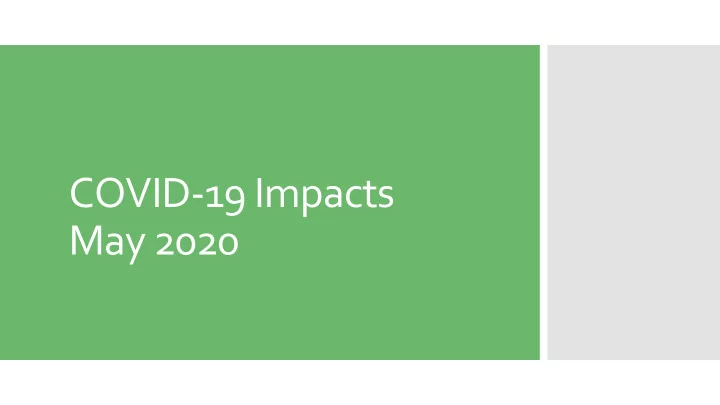

COVID-19 Impacts May 2020
“Both the depth and the duration of the economic downturn are extraordinarily Quote: uncertain and will depend in large part Jerome on how quickly the virus is brought under control. The severity of the Powell, Chair downturn will also depend on the policy of the Federal actions taken at all levels of government to cushion the blow and to Reserve support the recovery when the public May 13 health crisis passes.”
What we know FY 2020 general fund revenue is starting to see signs of the economic event, timing of payments is slowing the recognition of many of the anticipated impacts Revenue reductions will become more apparent by the close of the fiscal year and FY 2021 is expected to have significant declines Montana’s financial reserves are strong and in a better position than most states to weather the storm The next several years of state and local revenue and the economy are highly uncertain Federal support to date has been for direct COVID-19 spending only Federal support for state and local government revenue is being debated
Personal Income Tax Withholding – very small decline in cumulative year-over-year
Delay in tax payments
Corporate Income Tax Estimated Payments
Video Gaming Third quarter of FY 2020 or January through March of 2020 Video Gaming starts to show decline
FY 2021 In millions Beginning fund balance – FY 2021 $291.4 standard assumptions General Fund Balance Sheet HJ 2 Revenues 2,572.9 basics with HJ2 Expenditures – appropriations net of Revenues 2,566.7 standard reversions Ending fund balance $297.5
General Fund Balance FY 2020 $500 $450 FY 2020 anticipated ending fund balance = FY 2021 $400 beginning fund balance Fund Balance Cushion $350 Available $300 In times of financial stress, $ Millions revenue volatility may exhaust Fund Balance Cushion $250 the available fund balance cushion, including the Operating Reserve = $213 operating reserve. $200 $150 The general fund cushion is about $190 million or 7.4% of Minimum Balance = $103 FY 2021 revenues. $100 $50 $0
The reserve parameters designed to weather financial difficulties recommend maintaining an operating reserve balance of 8.3% of all general fund appropriations in the second year of the biennium, or about $213 million.
Statute requires a Minimum Ending Fund Balance minimum state Timetable general fund balance of 4% of general fund $ Millions appropriations in the Prior October 2020 4% $103 second year of the biennium prior to Oct-20 3% $77 October 2020. 1-Jan-21 2% $51 After October, Mar-21 1% $26 minimum balances drop incrementally as shown in the table.
Balances for Managing State Financial Stress = 18% of Annual General Fund Revenues • Reserves: $500 Fire Fund is $55 million $450 $55 Budget Stabilization $400 Reserve is $118 million $350 $118 General fund above the Fire Fund Balance minimum is about $190 $ Millions $300 Budget Stabilization Reserve Fund million Balance General Fund Balance $250 Total above the minimum is about 14% of annual $200 Fund Balance Cushion general fund appropriations or revenue $150 $100 Minimum Balance $50 $0 Estimated FY 2020 Balances
Moody’s Analytics has estimated Montana’s revenue shock through FY 2021 to be between 15.4% and 18.7% of annual revenue. If the state receives no federal revenue support, and revenues decline as indicated by Moody’s 15.4% Analytics, other methods may be needed to stabilize state finances. A combination of fund balance cushion, reserves, and assumed general fund expenditure reductions total 15.4% of FY 2021 revenues.
General fund reductions through the enhanced FMAP exceeding any additional cost to Medicaid General fund reductions through changing duties of state workers to work on COVID or state workers using Other qualified leave toward COVID related costs Other general fund reductions as “regular” needs fall to Possibilities be less and COVID related costs increase Federal revenue replacement for state and local government
May 14, 2020
May 15, 2020
Federal Education Spending
Economics
It will likely take two to three years for most economies to Quote: return to their pre-pandemic IHS Markit levels of output.
Montana Unemployment Rate Forecast 9.0 8.0 7.9 8.0 7.0 Unemployment Rate % 6.0 5.0 4.3 4.0 3.5 3.5 Montana April 3.0 2.0 1.0 0.0 2019 2020 2021 2022 2023 Year Source: Montana unemployment estimates from the April IHS state analysis report.
USA Unemployment Rate Forecast 16 14.9 13.5 14 12 Unemployment Rate % 9.5 10 7.9 8 USA May 6.6 USA April 6 4.8 4.3 3.6 3.7 4 2 0 2019 2020 2021 2022 2023 2024 Year Source: USA unemployment estimates from the April and May IHS Forecast Flash report.
IHS Unemployment Forecast 16 14.9 13.5 14 12 Unemployment Rate % 9.5 10 8.0 7.9 7.9 8 USA May 6.6 USA April 6 Montana April 4.8 4.3 4.3 3.6 3.7 4 3.5 2 3.5 0 2019 2020 2021 2022 2023 2024 Year Source: Montana unemployment estimates from the April Montana Forecast IHS report. USA unemployment estimates from the April and May IHS Forecast Flash report.
Real gross state product expected to drop 5% in 2020 to $44,833 million, but recover by 2021 to $47,550 million Unemployment expected to increase to 8.0% and 7.9% in 2020 and 2021 IHS Markit respectively, but recover to pre Covid-19 rates of 3.5% in 2023 Markit: Personal income projected growth to slow, but still remain positive in Montana 2020 Analysis from Change in total housing starts decreased by 25.2% and 21.2% in 2019 April and 2020, but expected to experience positive growth starting 2021 in addition to rising existing home prices Only industry expected to not experience job losses related to Covid-19 in 2020 is the federal government (BBER report)
Next Steps
Track Expenditures and Revenues on COVID-19 Track economic indicators Tracking Medicaid and other safety net programs Information as available Local Government revenue – property taxes Education revenue and spending on COVID-19 Revenue and Cashflow forecast updates
DASHBOARD JUNE REPORT JUNE MEETING CONTINUE WITH REVENUE FORECAST Next Steps JULY REPORT AUGUST MEETING AND FISCAL YEAR END REPORT
End
Recommend
More recommend